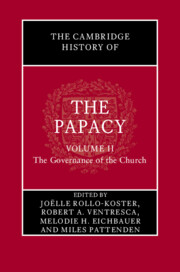Book contents
- The Cambridge History of the Papacy
- The Cambridge History of the Papacy
- Copyright page
- Contents
- Figures
- Tables
- Maps
- Contributors
- General Introduction
- Part I The Pope within the Church
- 1 Vicar of Christ, c.1050–c.1300
- 2 The Pope, the Archdeacon, and the Clergy: A Competition
- 3 From Papal Absolutism to Vatican II
- 4 Vatican II and Its Legacy
- 5 The Synod of Bishops since Vatican II
- Part II The Roman Curia
- Part III Canon Law
- Part IV Finance
- Part V Papal States
- Select Bibliography
- Index
4 - Vatican II and Its Legacy
from Part I - The Pope within the Church
Published online by Cambridge University Press: 28 February 2025
- The Cambridge History of the Papacy
- The Cambridge History of the Papacy
- Copyright page
- Contents
- Figures
- Tables
- Maps
- Contributors
- General Introduction
- Part I The Pope within the Church
- 1 Vicar of Christ, c.1050–c.1300
- 2 The Pope, the Archdeacon, and the Clergy: A Competition
- 3 From Papal Absolutism to Vatican II
- 4 Vatican II and Its Legacy
- 5 The Synod of Bishops since Vatican II
- Part II The Roman Curia
- Part III Canon Law
- Part IV Finance
- Part V Papal States
- Select Bibliography
- Index
Summary
After the First Vatican Council, some believed that a council was not necessary any more: the Pope alone was able to govern the Catholic Church. John XXIII’s decision to convene a council was surprising in this context. Considered by some as an extension of Vatican I, which originally was to produce a whole teaching on the Church in which the pope was to be situated, the Second Vatican Council teaching situates the pope in the people of God and within the College of Bishops, proclaiming the doctrine of collegiality. The two popes of the council were going to modify the figure and the style of the papacy. John XXIII, by developing fraternal ties with the non-Catholic Christians invited to the council and who came in large numbers; Paul VI gave worldwide influence to the papacy through his travels to Jerusalem, India, and to the United Nations headquarters in New York, establishing relationships with non-Christians.
- Type
- Chapter
- Information
- The Cambridge History of the Papacy , pp. 109 - 128Publisher: Cambridge University PressPrint publication year: 2025

